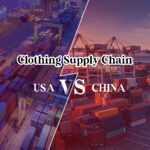Over the past decade, thousands of Chinese clothing manufacturers have begun selling directly to international consumers online, bypassing retailers that traditionally sourced their products from the country. Equipped with English-language social media profiles, Amazon seller accounts, and access to nimble garment supply chains, they have fuelled the acceleration of trends and flooded closets everywhere with a wave of impossibly cheap clothes.
Rest of World, a non-profit, tech-focused journalism outlet based in New York, spent six months investigating this new ecosystem, speaking with manufacturers, collecting social media and product data, making test buys, and interviewing shoppers and industry experts in China and the US. The results of that reporting reveal how Chinese apparel makers have evolved to cater to the desires of internet-native consumers – and transformed their consumption habits in the process. Capitalizing on this shift are companies such as Shein: the most successful, well-known, and well-funded online retailer of its kind.
Sheinis now one of the world’s largest fashion companies, but little is known about its origins. It was founded in 2012 under the name SheInside and reportedly began by selling wedding dresses abroad from its first headquarters in the Chinese city of Nanjing. (A spokesperson for Shein denied it ever sold wedding dresses, but declined to specify other details about its history.) The company says its founder, Chris Xu, was born in China, though a since-deleted press release described him as being from the US. Shein eventually expanded to offer apparel for women, men, and children, as well as everything from home goods to pet supplies, but its core business remains selling clothes targeted at women in their teens and 20s – a generation who grew up exploring their personal style on platforms like Instagram and Pinterest.
Shein’sclothes aren’t intended for Chinese customers but are destined for export. In May, the company became the most popular shopping app in the US on Android and iOS, and, the same month, topped the iOS rankings in more than 50 other countries. It’s the second-most popular fashion website in the world afterMacys.com.
By 2020, Shein’s sales had risen to $10bn, a 250% jump from the year before, according to Bloomberg. In June, the company accounted for 28% of all fast-fashion sales in the US – almost as much as H&M and Zara combined. The same month, a report circulated that Shein was worth more than $47bn, making it one of the tech industry’s most valuable private startups. (Shein declined to say whether the sales or valuation figures were accurate.)

Shein’s business model is aggressive. Comparisons to fast-fashion giants such as H&M miss the point: it’s more like Amazon, operating a sprawling online marketplace that brings together about 6,000 Chinese clothing factories. It unites them with proprietary internal management software that collects new-instant feedback about which items are hits or misses, which allows Shein to order new inventory virtually on demand. Designs are commissioned through the software – some original, others picked from the factories’ existing products. A polished advertising operation is layered over the top, run from Shein’s head offices in Guangzhou.
Through its manufacturing partners on the ground in China, Shein churns out and tests thousands of different items simultaneously. Between July and December of 2021, it added anywhere between 2,000 and 10,000 individual styles to its app each day, according to data collected in the course of the Rest of World’sinvestigations. The company confirmed that it starts by ordering a small batch of each garment, often a few dozen pieces, and then waits to see how buyers respond. If the cropped sweater vest is a hit, Shein orders more. It calls the system a “large-scale automated test and re-order (LATR) model”.
Rather than mimicking Amazon directly, Shein grew by bringing traits of China’sgamified e-commerce market to the rest of the world. Online shopping in the country has evolved into a form of entertainment, featuring live streamers, flash sales, and enticing pop-ups that compel consumers to scroll through the newest products. Taobao, a domestic Chinese e-commerce platform owned by Alibaba, helped pioneer interactive features such as custom product recommendations and even built a miniature social network into its app. Shein has used similar components on its platform, including a points system that rewards shoppers for making purchases, leaving reviews, and playing minigames.
For years, European brands such as Zara and H&M have embodied fast fashion, shortening the route from catwalk to shop window from months to weeks. ButShein isn’t chasing catwalk trends – rather, it often knocks off items seen on TikTok and Instagram, where hype cycles move significantly faster. Whereas Zaratypically asks manufacturers to turn around minimum orders of 2,000 items in 30 days, Shein asks for as few as 100 products in as little as 10 days.







